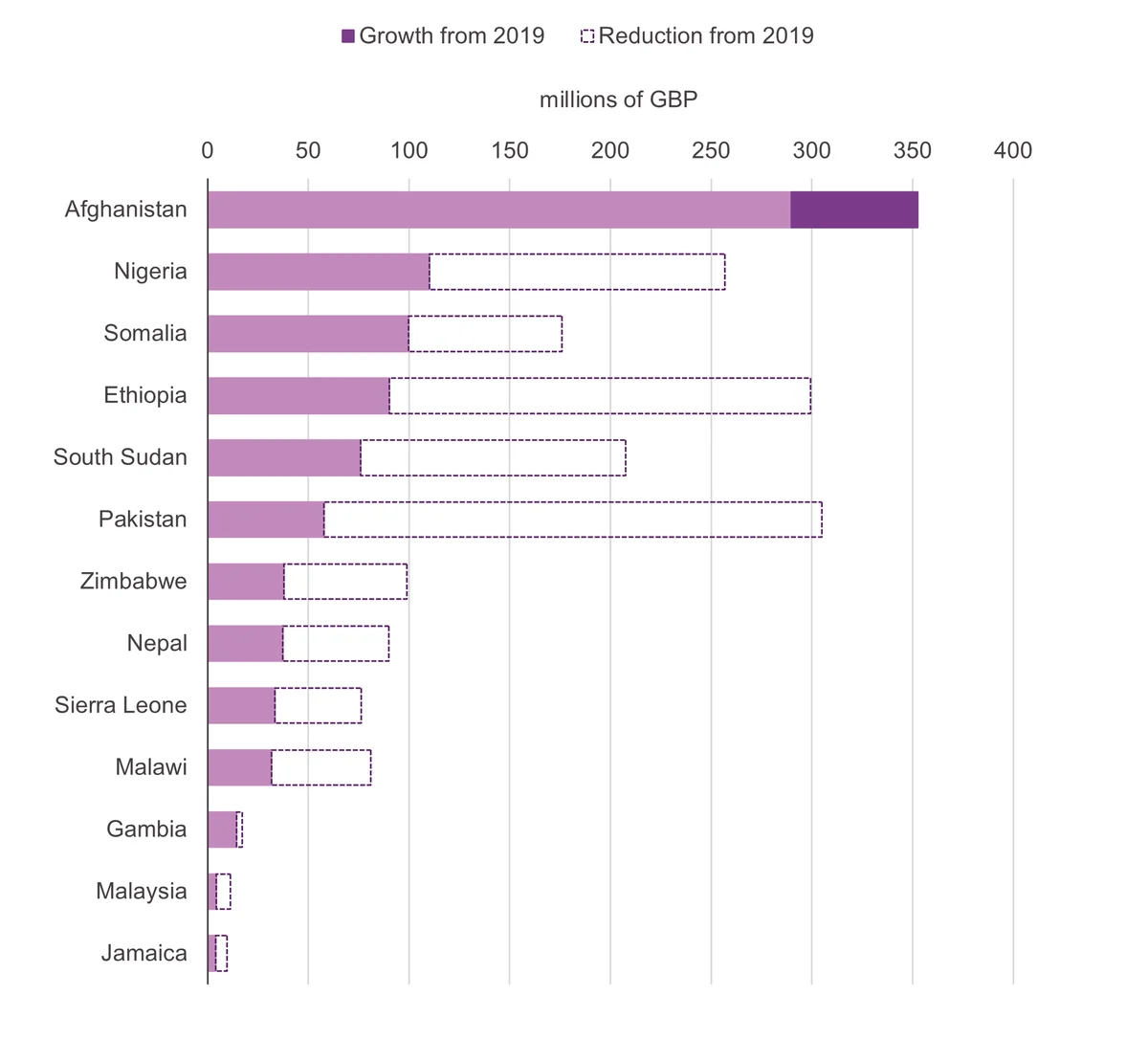Three years of UK aid cuts: where has ODA been hit hardest?
Following a consistent decline in UK ODA over the past three years, this factsheet reviews the changes in sectoral and country allocations with a particular focus on the rise in in-donor refugee costs.
DownloadsIntroduction
This factsheet analyses several major trends in the United Kingdom’s allocation of official development assistance (ODA) between 2018 and 2022. UK ODA has steadily declined since 2019, in part due to the government's temporary self-imposed reduction in aid spending from 0.7% to 0.5% of gross national income (GNI) following the pandemic. Alongside this reduction, certain areas of aid have experienced substantial increases in recent years, while several others have declined. 2022 saw a large increase in refugee costs, driven both by Russia’s invasion of Ukraine, as well as the high costs of hosting asylum seekers in temporary accommodation. The government’s inclusion of these costs under the reduced aid budget (0.51% of GNI in 2022) implies that less finance was subsequently available for world’s poorest countries. However, the most recent FCDO report – along with forecasts that UK GNI will increase steadily in coming years – suggest that the cuts to the UK aid budget in recent years are largely behind us. This factsheet thus reviews the extent of the cuts between 2019 and 2022, using the UK’s recent data release to delve deeper into the impacts by country and sector.
► Read more from DI about ODA (aid)
► Share your thoughts with us on Twitter or LinkedIn
► Sign up to our newsletter
Box 1:
About the data in this paper
The analysis in this factsheet is based off the Statistics on International Development: Final UK Aid Spend 2022 report which was published by Foreign, Commonwealth & Development Office (FCDO) in September. This report provides the final figures for ODA data in 2022, updating the previous release earlier this year by adding details such as recipient-specific data.
All United Kingdom figures are based on FCDO data, and thus are shown in GBP (current prices, 2022). When UK flows are compared with other donor countries, USD (constant prices, 2021) are used as these figures are based on the Organisation for Economic Co-operation and Development (OECD) Creditor Reporting System grant-equivalent data.
In this factsheet, we estimate the UK’s share of total ODA received by recipient countries. As the 2022 figures for ODA received by eligible countries from other providers is unavailable at the time of this analysis, we assume that ODA from other providers is unchanged relative to 2021.
Key facts
- In-donor refugee costs were the largest component of UK ODA in 2022, accounting for approximately 30% of total aid after increasing around threefold since 2021 ( Figure 1 ).
- The rapid increase in in-donor refugee costs from 2021 onwards was driven primarily by a surge in initial accommodation costs and Ukraine-related projects ( Figure 2 ).
- While refugee costs have risen nearly eightfold, every other ODA sector has experienced a decrease in real volume since 2019 ( Figure 3 ).
- UK ODA to LDCs, LMICs and UMICs has seen an overall decrease since 2019, falling by 55%, 49% and 49% respectively ( Figure 4 ).
- The UK has reduced its bilateral aid towards most recipient countries, including recipients which previously received significant shares of their aid from the UK ( Figure 5 ).
- ODA recipient countries that previously received significant bilateral aid disbursements from the UK have subsequently seen large declines following the drop in UK ODA ( Figure 6 ).
Out of all sectors, in-donor refugee costs saw the largest increase in aid in 2022
Figure 1: Aside from in-donor refugee costs, all other sectors decreased relative to 2021
United Kingdom in-donor refugee costs and total ODA, 2019–2022
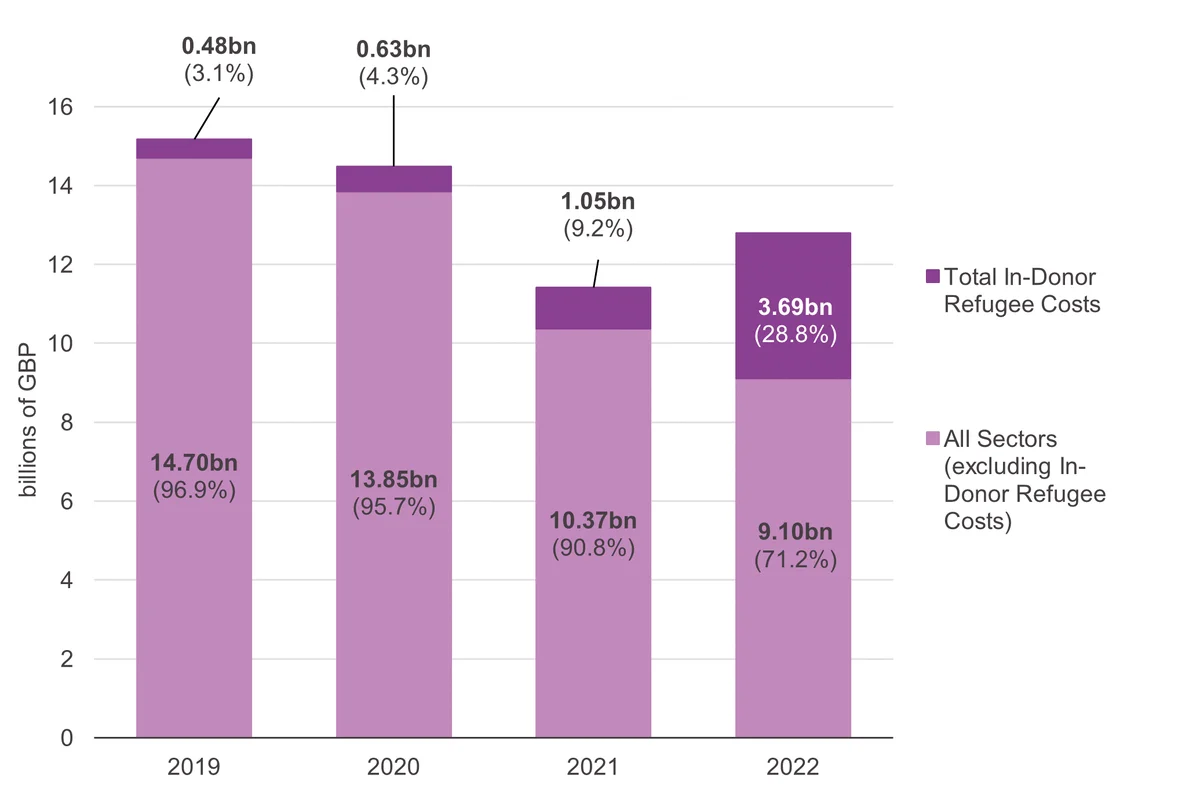
placeholder
Source: Development Initiatives based on Foreign, Commonwealth & Development Office (FCDO) data, September 2023.
Notes: ODA = official development assistance.
- Between 2021 and 2022, total UK ODA increased from £11.4 billion to £12.8 billion. This represented an increase of 0.5% to 0.51% of GNI, £270 million more than if the UK had stuck to its 0.5% of GNI target. However, this additional funding was significantly less than the increase in in-donor refugee costs.
- In-donor refugee costs increased by roughly 250% between 2021 and 2022, from £1.05 billion to £3.69 billion. This increase was primarily driven by a sharp rise in flows towards initial accommodation for housing asylum seekers.
- In-donor refugee costs were the largest component of UK aid in 2022, accounting for 28.8% of total ODA.
- Within the in-donor refugee costs purpose code, 57% of ODA was allocated for food and shelter, a decrease from the consistent ~75% it accounted for in previous years, largely due to the increase in flows tagged as ‘non-sector allocable’. [1] The most significant projects under this tag were resettlement and home schemes for Ukrainian and Afghan asylum seekers.
Increasing initial accommodation and Ukraine-related financing needs led to a sharp rise in refugee costs
Figure 2: The sharp rise in refugee costs was driven by increases in initial accommodation and Ukraine-related financing needs
Breakdown of UK ODA in-donor refugee costs, 2019–2022
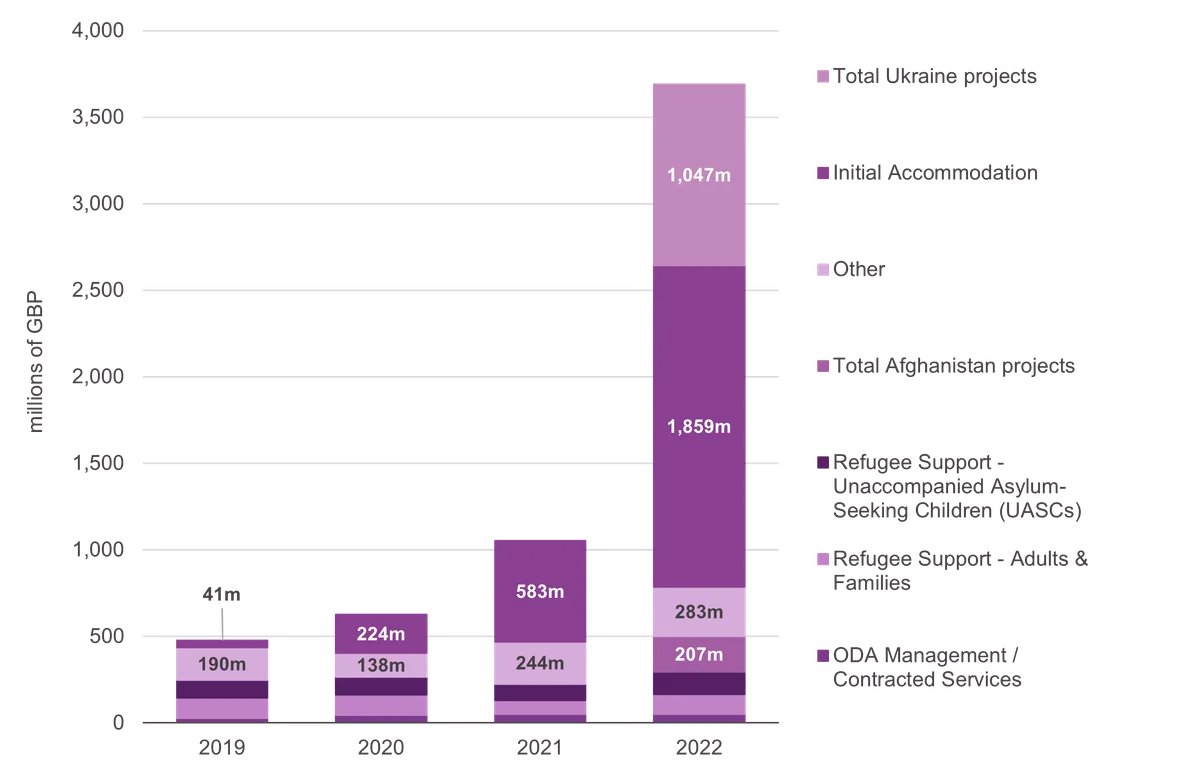
placeholder
Source: Development Initiatives based on Foreign, Commonwealth & Development Office (FCDO) data, September 2023.
Notes: ODA = official development assistance. Total Ukraine projects includes all in-donor refugee costs with the word ‘Ukraine’ in the project title and consists of flows under the following project titles as listed the FCDO: child benefit assistance for Ukraine refugees fleeing conflict in Ukraine, Homes for Ukraine, Homes for Ukraine – education funding (22–23 FY), Homes for Ukraine scheme, Ukraine extension scheme, Ukraine families visa scheme, Ukraine Family Scheme, Ukraine Extension Scheme, Homes for Ukraine Scheme. Total Afghanistan projects consists of flows under the project titles as listed by the FCDO: Afghan citizens resettlement scheme (ACRS), Afghan resettlement scheme – ACRS element, Afghanistan citizens healthcare costs in bridging accommodation and child benefit assistance for Afghan refugees fleeing conflict in Afghanistan. ‘Other’ consists of remaining project titles under refugees in donor countries (broad sector code 930).
- Initial accommodation for asylum seekers accounted for £1.86 billion in 2022 – 50% of all in-donor refugee costs (IDRC) and 15% of total ODA. This was an increase of more than 300% from 2021 and was spent primarily on hotels for asylum seekers to stay in temporarily.
- As stated in a previous DI blog , the increase in the number of asylum seekers did contribute – albeit not significantly – to the jump in IDRC but the primary driver for the increase was increased spending on initial accommodation. The Statistics on International Development Final Aid Spend 2022 report confirms that the increase was driven by higher accommodation spending, as well as temporary protection visa schemes for Ukrainians.
- The second highest allocation in 2022 was towards Ukraine-specific projects, which accounted for 28% (£1.05 billion) of in-donor refugee costs in 2022. These projects were introduced in response to the war in Ukraine to accommodate asylum seekers. Excluding Ukraine-specific costs, in-donor refugee costs would still have more than doubled.
- The third highest allocation was towards Afghanistan-specific projects, another new allocation in 2022. These projects accounted for 6% (£207 million) of total in-donor refugee costs.
- Besides initial accommodation and Ukraine-based projects, the remainder of in-donor refugee allocations in 2022 were primarily channelled to several smaller projects have historically been nestled under this purpose code, including refugee support which accounted for 6% of IDRC (£242 million total) and ODA management at 1% (£52 million total).
Aside from in-donor refugee costs, aid towards all other sectors has declined since 2019
Figure 3: In-donor refugee costs are the only subset of UK ODA to have increased since 2019
Changes in volume of UK ODA by sector, 2019–2022
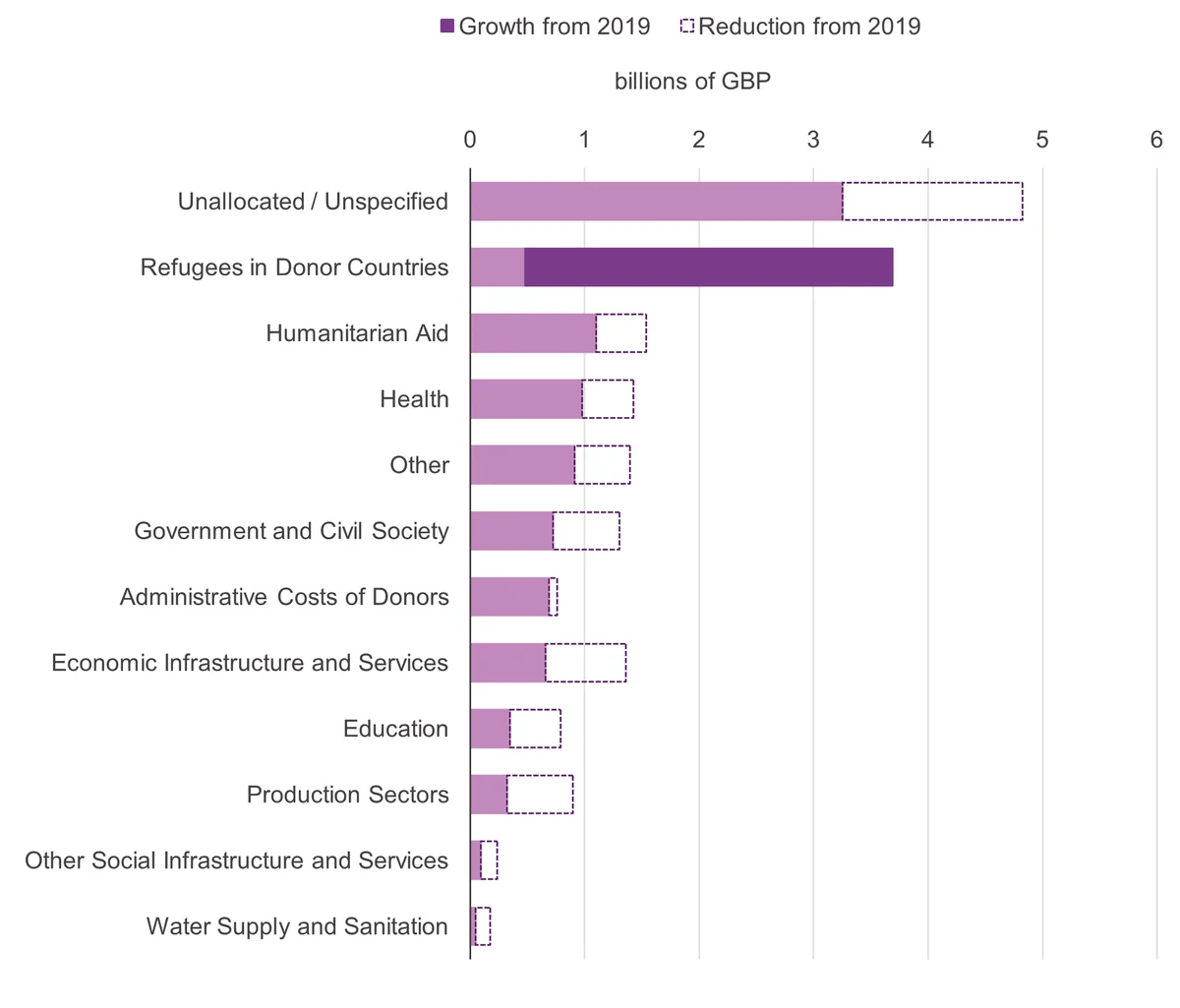
placeholder
Source: Development Initiatives based on Foreign, Commonwealth & Development Office (FCDO) data, September 2023.
Notes: ODA = official development assistance.
- Since 2019, funding towards in-donor refugee costs have experienced a disproportionate increase in UK ODA, while every other sector has experienced a gradual decrease.
- Several sectors covering basic needs have seen significant decreases in funding. Areas such as Education and Water Supply & Sanitation have decreased by 56% (from £789 million to £344 million) and 74% (from £176 million to £46 million) respectively.
- Healthcare has also seen a steep decrease in funding in recent years and has fallen by 32% since 2019 (from £1.43 billion to £976 million). When excluding allocations towards Covid-19 control, that figure is even lower, coming in at £742 million in 2022.
- By way of illustrating the imbalance in UK ODA to different sectors, in-donor refugee costs have risen by 673% over the same period.
- Despite the downward trend in aid to most sectors from 2019 onwards, six out of the 14 listed sectors experienced an increase in the volume of aid between 2021 and 2022.
- Besides in-donor refugee costs, the most significant of these sectoral increases in 2022 was Humanitarian Aid, which increased from £743 million to £1.1 billion, largely due to allocations to Ukraine. While this is a significant increase and represents a positive change for UK aid, it has not reversed the sector’s overall downwards trend since 2019.
- While the UK slightly exceeded its aid target of 0.5% of GNI in 2022, the total amount was far below the increase in in-donor refugee costs. The decision to count such costs under the ODA budget meant that there was less money available for other sectors. As outlined in a previous DI blog , this is partly because the Home Office has less incentive to try to control and allocate costs efficiently as these flows will not count towards any of its programmes. Consequently, refugee costs may have absorbed much of the FCDO’s aid budget, squeezing other sectors under the 0.51% of GNI aid budget.
While domestic spending has risen, aid towards the world’s poorest countries has decreased
Figure 4: UK ODA to LDCs and/or LICs, LMICs and UMICs has decreased since 2021
UK ODA by income group, 2019–2022
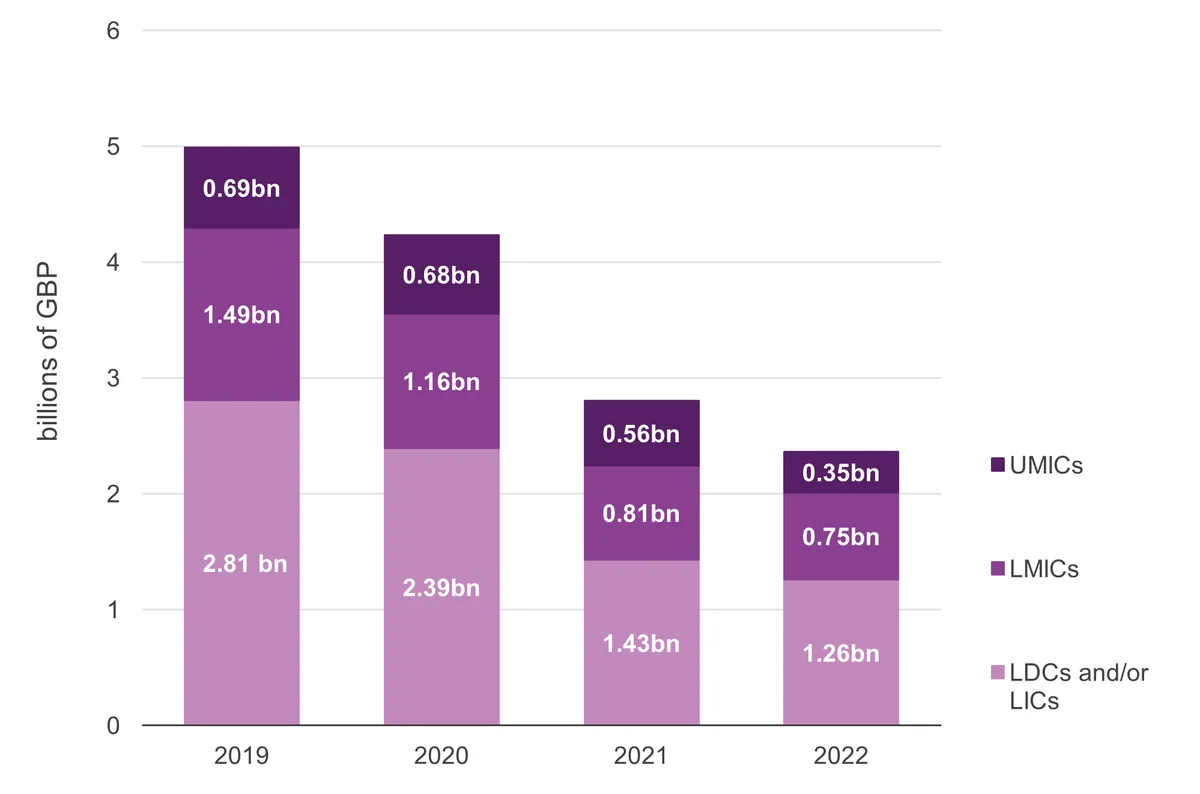
placeholder
Source: Development Initiatives based on Foreign, Commonwealth & Development Office (FCDO) data, September 2023.
Notes: ODA = official development assistance; LDC = least developed country; LIC = low-income country; LMIC = lower-middle-income country; UMIC = upper-middle-income country. Flows unallocated by income group are excluded from this chart. LDCs and LICs are grouped together to distinguish that some LICs are not classified as LDCs.
- Since 2019, the real volume of UK ODA has decreased for all ODA-eligible income groups.
- Lower- and middle-income countries have experienced similar decreases in the volume of aid received from the UK. Since 2019, least developed countries (LDCs) and/or low-income countries (LICs) have seen a 55% reduction in UK ODA (from £2.81 billion to £1.26 billion). At the same time, UK ODA to lower-middle-income countries (LMICs) and upper-middle-income countries (UMICs) has fallen by around 49%: from £1.49 billion to £752 million and from £690 million to £350 million respectively.
- Consequently, the share of ODA to LICs has fallen. In 2019, flows to LDCs and/or LICs accounted for roughly 19% of total UK ODA, whereas in 2022 it was just 10%.
- In 2022, total UK ODA disbursements decreased for almost every LDC and/or LIC, with the most notable exception being Afghanistan. This represents a continuation in the overall decline in flows to LICs from 2019 onwards.
The countries that rely heavily on UK aid have been most impacted by ODA cuts
Figure 6: 11 of the 13 countries that received the largest mean share of UK bilateral aid as a proportion of total ODA in 2019 have seen a decrease in that share
Changes in the share of UK ODA as part of total ODA from official donors to select recipient countries, 2019–2022
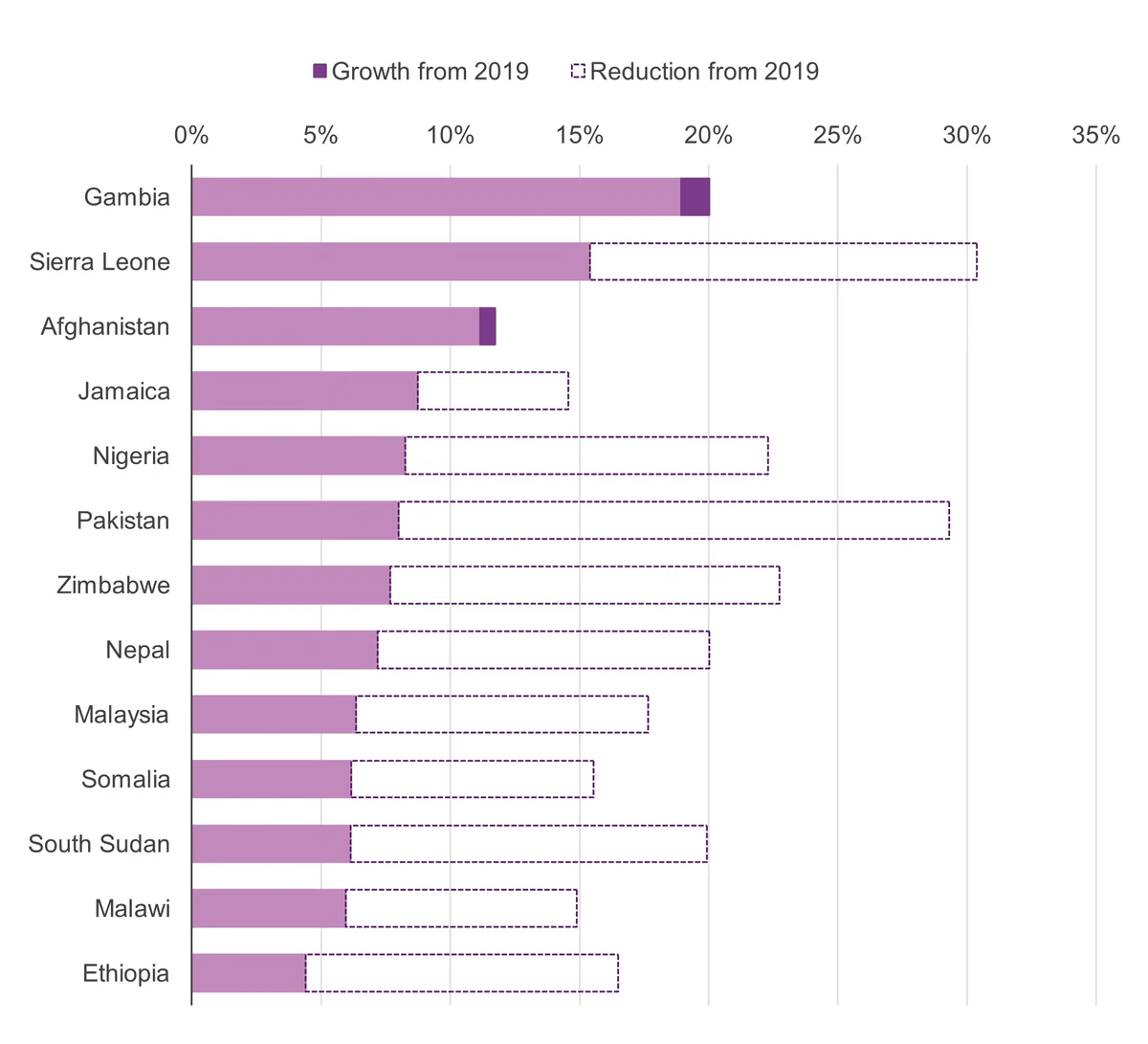
placeholder
Source: Development Initiatives based on Foreign, Commonwealth & Development Office (FCDO) and Organisation for Economic Co-operation and Development (OECD) data, September 2023.
Notes: ODA = official development assistance. Countries are ordered by volume (Figure 5) and share (Figure 6) of received bilateral ODA from the UK in 2022. ODA data for 2022 is not yet available for other recipient countries. We thus assume that the total received aid is unchanged from 2021. The recipient countries shown in these charts received the largest mean share of UK bilateral ODA as a share of total ODA from official donors from 2018–2022.
- Since 2021, total UK ODA disbursements have decreased for almost every least developed country (LDC) with the most notable exception being Afghanistan. This continues the overall decline in flows to lower-income countries from 2019 onwards. Of the 13 countries for which the UK’s aid was the most significant (measured by the share of UK’s aid in total aid received since 2018), 11 saw a decrease in the volume of aid received from the UK between 2019 and 2022.
- Pakistan has experienced the largest real decrease in UK aid, from £305 million in 2019 to just £56 million in 2022. This represents a drop in the UK’s share of total aid received by Pakistan from 13% in 2019 to our estimate of 2% in 2022. Over the past decade, both the UK and the US have together accounted for around 50–70% of all bilateral aid to Pakistan. Declining flows from both donors have contributed to Pakistan’s total received bilateral aid roughly halving between 2019 and 2021.
- In 2018, aid from the UK accounted for 45% of total bilateral aid received by Sierra Leone. In 2021, this share decreased to 32%, contributing to the total bilateral ODA received by the country decreasing by roughly a third.
- Countries such as Nigeria, South Sudan and Zimbabwe – which previously received substantial shares of their total bilateral aid from the UK – have been most impacted by these cuts. In 2019, UK bilateral ODA accounted for roughly 20–23% of total received bilateral aid for each of these countries. While data is not yet available for 2022, if the total amount of ODA to these countries remains unchanged, the UK’s share will have fallen to roughly 6–8% for each recipient.
- Since 2019, UK bilateral ODA to South Sudan has decreased by £131 million. This amount represented roughly 2% of the country’s GDP in 2022 .
Conclusion
Since the UK government’s decision to reduce the aid budget to 0.5% of GNI, official development assistance (ODA) to many important sectors has declined. While in-donor refugee costs have increased significantly, aid towards the world’s poorest countries has consistently fallen. This has had the most noteworthy impacts on the countries which had previously received high shares of their total aid from the UK.
Despite half of all sectors experiencing an increase in ODA, the downward trend in UK aid continued in 2022 (excluding refugee costs). While refugee costs experienced high increases, it is possible that their share of UK ODA will have been at its highest in 2022, as the impact of the Ukraine crisis on in-donor refugee costs is likely to fall in the coming years . Furthermore, following recent policy changes that prevent anyone arriving in the UK via channel crossings from applying for asylum, the UK will potentially no longer be allowed to count initial accommodation costs as aid . Finally, the most recent FCDO annual report indicates an increase in ODA in coming years, in particular for the poorest countries . Therefore, while the last three years have seen significant reductions in ODA, there remains signs of a brighter future for UK aid.
Acknowledgements
Paul Wozniak was the author of this factsheet. Euan Ritchie and Maria Ana Jalles d'Orey provided advice on framing and content, and Euan Ritchie conducted extensive data checks.
Notes
-
1
This is labelled as sector purpose code 93010 and refers to flows which cannot be categorised into existing sub-sectors.Return to source text
Related content
UK aid trends in a challenging global context
Government aid cuts and converging global crises have had a substantial impact on the UK's ability to deliver on its development goals. In this briefing, we contextualise and analyse trends in UK ODA over the past decade.
New DAC data reveals the impact of the Ukraine invasion on aid
The rise in in-donor refugee costs associated with the Ukraine invasion means less money for LDCs. The latest DAC data shows they are paying the price for challenges elsewhere.
Spiralling emergency accommodation costs from the UK’s Home Office are diverting aid from the world’s poorest
This blog argues that the UK should remove in-donor refugee costs from its aid target to avoid failing the people most in need.
